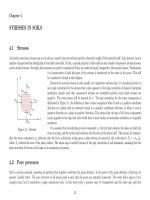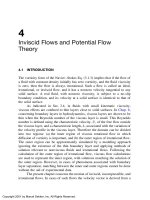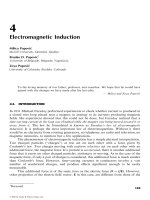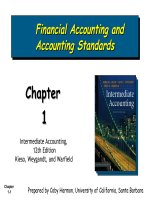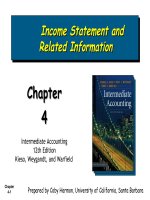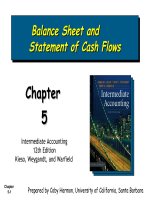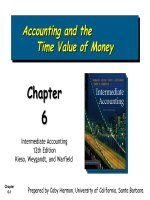- Trang chủ >>
- Khoa Học Tự Nhiên >>
- Vật lý
Hibbeler engineering mechanics (solutions manual) statics 12th edition engineering mechanics chapter 4
Bạn đang xem bản rút gọn của tài liệu. Xem và tải ngay bản đầy đủ của tài liệu tại đây (13.01 MB, 130 trang )
4 Solutions 44918
1/23/09
12:03 PM
Page 190
© 2010 Pearson Education, Inc., Upper Saddle River, NJ. All rights reserved. This material is protected under all copyright laws as they currently
exist. No portion of this material may be reproduced, in any form or by any means, without permission in writing from the publisher.
•4–1. If A, B, and D are given vectors, prove the
distributive law for the vector cross product, i.e.,
A : (B + D) = (A : B) + (A : D).
190
4 Solutions 44918
1/23/09
12:03 PM
Page 191
© 2010 Pearson Education, Inc., Upper Saddle River, NJ. All rights reserved. This material is protected under all copyright laws as they currently
exist. No portion of this material may be reproduced, in any form or by any means, without permission in writing from the publisher.
4–2. Prove the triple
A # B : C = A : B # C.
scalar
product
identity
191
4 Solutions 44918
1/23/09
12:03 PM
Page 192
© 2010 Pearson Education, Inc., Upper Saddle River, NJ. All rights reserved. This material is protected under all copyright laws as they currently
exist. No portion of this material may be reproduced, in any form or by any means, without permission in writing from the publisher.
4–3. Given the three nonzero vectors A, B, and C, show
that if A # (B : C) = 0, the three vectors must lie in the
same plane.
*4–4. Two men exert forces of F = 80 lb and P = 50 lb on
the ropes. Determine the moment of each force about A.
Which way will the pole rotate, clockwise or counterclockwise?
6 ft
P
F
45Њ
3
12 ft
B
5
4
C
A
•4–5. If the man at B exerts a force of P = 30 lb on his
rope, determine the magnitude of the force F the man at C
must exert to prevent the pole from rotating, i.e., so the
resultant moment about A of both forces is zero.
6 ft
P
F
45Њ
3
B
12 ft
5
4
C
A
192
4 Solutions 44918
1/23/09
12:03 PM
Page 193
© 2010 Pearson Education, Inc., Upper Saddle River, NJ. All rights reserved. This material is protected under all copyright laws as they currently
exist. No portion of this material may be reproduced, in any form or by any means, without permission in writing from the publisher.
4–6. If u = 45°, determine the moment produced by the
4-kN force about point A.
3m
A
0.45 m
u
4 kN
193
4 Solutions 44918
1/23/09
12:03 PM
Page 194
© 2010 Pearson Education, Inc., Upper Saddle River, NJ. All rights reserved. This material is protected under all copyright laws as they currently
exist. No portion of this material may be reproduced, in any form or by any means, without permission in writing from the publisher.
4–7. If the moment produced by the 4-kN force about
point A is 10 kN # m clockwise, determine the angle u, where
0° … u … 90°.
3m
A
0.45 m
u
4 kN
194
4 Solutions 44918
1/23/09
12:03 PM
Page 195
© 2010 Pearson Education, Inc., Upper Saddle River, NJ. All rights reserved. This material is protected under all copyright laws as they currently
exist. No portion of this material may be reproduced, in any form or by any means, without permission in writing from the publisher.
*4–8. The handle of the hammer is subjected to the force
of F = 20 lb. Determine the moment of this force about the
point A.
F
30Њ
5 in.
18 in.
A
B
195
4 Solutions 44918
1/23/09
12:03 PM
Page 196
© 2010 Pearson Education, Inc., Upper Saddle River, NJ. All rights reserved. This material is protected under all copyright laws as they currently
exist. No portion of this material may be reproduced, in any form or by any means, without permission in writing from the publisher.
•4–9. In order to pull out the nail at B, the force F exerted
on the handle of the hammer must produce a clockwise
moment of 500 lb # in. about point A. Determine the
required magnitude of force F.
F
30Њ
5 in.
18 in.
A
B
196
4 Solutions 44918
1/23/09
12:03 PM
Page 197
© 2010 Pearson Education, Inc., Upper Saddle River, NJ. All rights reserved. This material is protected under all copyright laws as they currently
exist. No portion of this material may be reproduced, in any form or by any means, without permission in writing from the publisher.
4–10. The hub of the wheel can be attached to the axle
either with negative offset (left) or with positive offset
(right). If the tire is subjected to both a normal and radial
load as shown, determine the resultant moment of these
loads about point O on the axle for both cases.
0.05 m
O
0.05 m
O
0.4 m
0.4 m
800 N
197
800 N
4 kN
4 kN
Case 1
Case 2
4 Solutions 44918
1/23/09
12:03 PM
Page 198
© 2010 Pearson Education, Inc., Upper Saddle River, NJ. All rights reserved. This material is protected under all copyright laws as they currently
exist. No portion of this material may be reproduced, in any form or by any means, without permission in writing from the publisher.
4–11. The member is subjected to a force of F = 6 kN. If
u = 45°, determine the moment produced by F about
point A.
1.5 m
u
F ϭ 6 kN
6m
A
198
4 Solutions 44918
1/23/09
12:03 PM
Page 199
© 2010 Pearson Education, Inc., Upper Saddle River, NJ. All rights reserved. This material is protected under all copyright laws as they currently
exist. No portion of this material may be reproduced, in any form or by any means, without permission in writing from the publisher.
*4–12. Determine the angle u (0° … u … 180°) of the
force F so that it produces a maximum moment and a
minimum moment about point A. Also, what are the
magnitudes of these maximum and minimum moments?
1.5 m
u
F ϭ 6 kN
6m
A
199
4 Solutions 44918
1/23/09
12:03 PM
Page 200
© 2010 Pearson Education, Inc., Upper Saddle River, NJ. All rights reserved. This material is protected under all copyright laws as they currently
exist. No portion of this material may be reproduced, in any form or by any means, without permission in writing from the publisher.
•4–13. Determine the moment produced by the force F
about point A in terms of the angle u. Plot the graph of MA
versus u, where 0° … u … 180°.
1.5 m
u
F ϭ 6 kN
6m
A
200
4 Solutions 44918
1/23/09
12:03 PM
Page 201
© 2010 Pearson Education, Inc., Upper Saddle River, NJ. All rights reserved. This material is protected under all copyright laws as they currently
exist. No portion of this material may be reproduced, in any form or by any means, without permission in writing from the publisher.
4–14. Serious neck injuries can occur when a football
player is struck in the face guard of his helmet in the
manner shown, giving rise to a guillotine mechanism.
Determine the moment of the knee force P = 50 lb about
point A. What would be the magnitude of the neck force F
so that it gives the counterbalancing moment about A?
2 in.
60Њ
A
P ϭ 50 lb
4 in.
F
6 in.
30Њ
4–15. The Achilles tendon force of Ft = 650 N is
mobilized when the man tries to stand on his toes. As this is
done, each of his feet is subjected to a reactive force of
Nf = 400 N. Determine the resultant moment of Ft and Nf
about the ankle joint A.
Ft
5Њ
A
200 mm
65 mm
201
100 mm
Nf ϭ 400 N
4 Solutions 44918
1/23/09
12:03 PM
Page 202
© 2010 Pearson Education, Inc., Upper Saddle River, NJ. All rights reserved. This material is protected under all copyright laws as they currently
exist. No portion of this material may be reproduced, in any form or by any means, without permission in writing from the publisher.
Ft
*4–16. The Achilles tendon force Ft is mobilized when the
man tries to stand on his toes. As this is done, each of his feet
is subjected to a reactive force of Nt = 400 N. If the resultant
moment produced by forces Ft and Nt about the ankle joint
A is required to be zero, determine the magnitude of Ft.
5Њ
A
200 mm
65 mm
•4–17. The two boys push on the gate with forces of
FA = 30 lb and as shown. Determine the moment of each
force about C. Which way will the gate rotate, clockwise or
counterclockwise? Neglect the thickness of the gate.
6 ft
100 mm
3 ft
4
A
C
B
Nf ϭ 400 N
FA
3
5
60Њ
FB
4–18. Two boys push on the gate as shown. If the boy at B
exerts a force of FB = 30 lb, determine the magnitude of
the force FA the boy at A must exert in order to prevent the
gate from turning. Neglect the thickness of the gate.
6 ft
3 ft
4
A
C
B
60Њ
FB
202
FA
3
5
4 Solutions 44918
1/23/09
12:03 PM
Page 203
© 2010 Pearson Education, Inc., Upper Saddle River, NJ. All rights reserved. This material is protected under all copyright laws as they currently
exist. No portion of this material may be reproduced, in any form or by any means, without permission in writing from the publisher.
4–19. The tongs are used to grip the ends of the drilling
pipe P. Determine the torque (moment) MP that the
applied force F = 150 lb exerts on the pipe about point P
as a function of u. Plot this moment MP versus u for
0 … u … 90°.
F
u
P
6 in.
MP
43 in.
*4–20. The tongs are used to grip the ends of the drilling
pipe P. If a torque (moment) of MP = 800 lb # ft is needed
at P to turn the pipe, determine the cable force F that must
be applied to the tongs. Set u = 30°.
F
u
P
6 in.
MP
43 in.
203
4 Solutions 44918
1/23/09
12:03 PM
Page 204
© 2010 Pearson Education, Inc., Upper Saddle River, NJ. All rights reserved. This material is protected under all copyright laws as they currently
exist. No portion of this material may be reproduced, in any form or by any means, without permission in writing from the publisher.
•4–21. Determine the direction u for 0° … u … 180° of the
force F so that it produces the maximum moment about
point A. Calculate this moment.
F ϭ 400 N
u
2m
A
3m
204
4 Solutions 44918
1/23/09
12:03 PM
Page 205
© 2010 Pearson Education, Inc., Upper Saddle River, NJ. All rights reserved. This material is protected under all copyright laws as they currently
exist. No portion of this material may be reproduced, in any form or by any means, without permission in writing from the publisher.
F ϭ 400 N
4–22. Determine the moment of the force F about point A
as a function of u. Plot the results of M (ordinate) versus u
(abscissa) for 0° … u … 180°.
u
2m
A
3m
4–23. Determine the minimum moment produced by
the force F about point A. Specify the angle u (0° …
u … 180°).
F ϭ 400 N
u
2m
A
3m
205
4 Solutions 44918
1/23/09
12:03 PM
Page 206
© 2010 Pearson Education, Inc., Upper Saddle River, NJ. All rights reserved. This material is protected under all copyright laws as they currently
exist. No portion of this material may be reproduced, in any form or by any means, without permission in writing from the publisher.
*4–24. In order to raise the lamp post from the position
shown, force F is applied to the cable. If F = 200 lb,
determine the moment produced by F about point A.
B
F
20 ft
C
75Њ
A
10 ft
206
4 Solutions 44918
1/23/09
12:03 PM
Page 207
© 2010 Pearson Education, Inc., Upper Saddle River, NJ. All rights reserved. This material is protected under all copyright laws as they currently
exist. No portion of this material may be reproduced, in any form or by any means, without permission in writing from the publisher.
•4–25. In order to raise the lamp post from the position
shown, the force F on the cable must create a counterclockwise
moment of 1500 lb # ft about point A. Determine the
magnitude of F that must be applied to the cable.
B
F
20 ft
C
75Њ
A
10 ft
207
4 Solutions 44918
1/23/09
12:03 PM
Page 208
© 2010 Pearson Education, Inc., Upper Saddle River, NJ. All rights reserved. This material is protected under all copyright laws as they currently
exist. No portion of this material may be reproduced, in any form or by any means, without permission in writing from the publisher.
F2 ϭ 30 lb
4–26. The foot segment is subjected to the pull of the two
plantarflexor muscles. Determine the moment of each force
about the point of contact A on the ground.
F1 ϭ 20 lb
30Њ
70Њ
60Њ
4 in.
A
1 in.
4–27. The 70-N force acts on the end of the pipe at B.
Determine (a) the moment of this force about point A, and
(b) the magnitude and direction of a horizontal force, applied
at C, which produces the same moment. Take u = 60°.
3.5 in.
A
0.9 m
70 N
u
B
C
0.3 m
208
0.7 m
4 Solutions 44918
1/23/09
12:03 PM
Page 209
© 2010 Pearson Education, Inc., Upper Saddle River, NJ. All rights reserved. This material is protected under all copyright laws as they currently
exist. No portion of this material may be reproduced, in any form or by any means, without permission in writing from the publisher.
*4–28. The 70-N force acts on the end of the pipe at B.
Determine the angles u 10° … u … 180°2 of the force that
will produce maximum and minimum moments about
point A. What are the magnitudes of these moments?
A
0.9 m
70 N
u
B
C
0.3 m
•4–29. Determine the moment of each force about the
bolt located at A. Take FB = 40 lb, FC = 50 lb.
209
0.7 m
4 Solutions 44918
1/23/09
12:03 PM
Page 210
© 2010 Pearson Education, Inc., Upper Saddle River, NJ. All rights reserved. This material is protected under all copyright laws as they currently
exist. No portion of this material may be reproduced, in any form or by any means, without permission in writing from the publisher.
4–30. If FB = 30 lb and FC = 45 lb, determine the resultant
moment about the bolt located at A.
4–31. The rod on the power control mechanism for a
business jet is subjected to a force of 80 N. Determine the
moment of this force about the bearing at A.
20Њ
60Њ
80 N
150 mm
A
*4–32. The towline exerts a force of P = 4 kN at the end
of the 20-m-long crane boom. If u = 30°, determine the
placement x of the hook at A so that this force creates a
maximum moment about point O. What is this moment?
B
P ϭ 4 kN
20 m
O
u
1.5 m
A
x
210
4 Solutions 44918
1/23/09
12:03 PM
Page 211
© 2010 Pearson Education, Inc., Upper Saddle River, NJ. All rights reserved. This material is protected under all copyright laws as they currently
exist. No portion of this material may be reproduced, in any form or by any means, without permission in writing from the publisher.
•4–33. The towline exerts a force of P = 4 kN at the end
of the 20-m-long crane boom. If x = 25 m, determine the
position u of the boom so that this force creates a maximum
moment about point O. What is this moment?
B
P ϭ 4 kN
20 m
O
u
1.5 m
A
x
211
4 Solutions 44918
1/23/09
12:03 PM
Page 212
© 2010 Pearson Education, Inc., Upper Saddle River, NJ. All rights reserved. This material is protected under all copyright laws as they currently
exist. No portion of this material may be reproduced, in any form or by any means, without permission in writing from the publisher.
4–34. In order to hold the wheelbarrow in the position
shown, force F must produce a counterclockwise moment
of 200 N # m about the axle at A. Determine the required
magnitude of force F.
B
F
0.65 m
G
0.5 m
A
1.2 m
0.3 m
212
30Њ
4 Solutions 44918
1/23/09
12:03 PM
Page 213
© 2010 Pearson Education, Inc., Upper Saddle River, NJ. All rights reserved. This material is protected under all copyright laws as they currently
exist. No portion of this material may be reproduced, in any form or by any means, without permission in writing from the publisher.
4–35. The wheelbarrow and its contents have a mass of
50 kg and a center of mass at G. If the resultant moment
produced by force F and the weight about point A is to be
zero, determine the required magnitude of force F.
B
F
0.65 m
G
0.5 m
A
1.2 m
0.3 m
213
30Њ
4 Solutions 44918
1/23/09
12:03 PM
Page 214
© 2010 Pearson Education, Inc., Upper Saddle River, NJ. All rights reserved. This material is protected under all copyright laws as they currently
exist. No portion of this material may be reproduced, in any form or by any means, without permission in writing from the publisher.
*4–36. The wheelbarrow and its contents have a center of
mass at G. If F = 100 N and the resultant moment produced
by force F and the weight about the axle at A is zero,
determine the mass of the wheelbarrow and its contents.
B
F
0.65 m
G
0.5 m
A
1.2 m
0.3 m
214
30Њ

